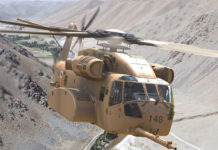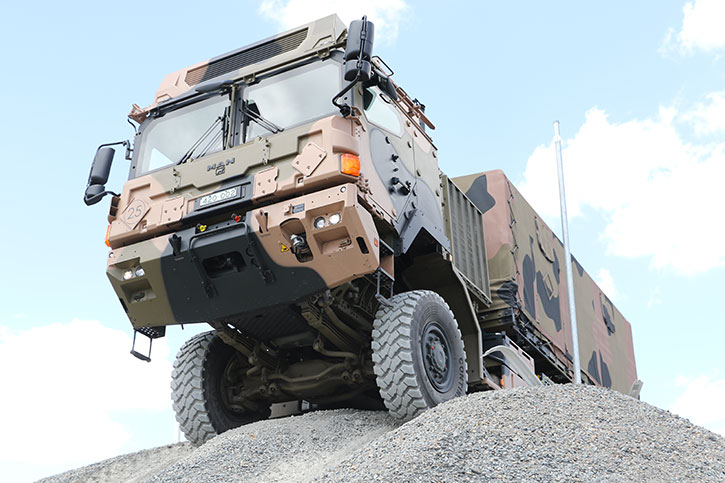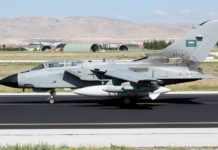As the U.S. Air Force’s B-52 Stratofortress turns 60, the B-52H is being upgraded and modernized to continue assuming long-range strike missions under the Air Force Global Strike Command. Lt. Gen. Jim Kowalski, commander of the Global StrikeCommand said the modernization and sustaining the nation’s long range strike aviation capability is a top priority for the command. The Air Force is marking both the 50th anniversary of the last delivery of a B-52H to Minot AFB, N.D., and the 60th anniversary of the first test flight of the YB-52. Kowalski attributed the reliability and combat capability of the dual-role bomber to the talented maintenance personnel, outstanding depot support and the Air Force’s continued investment in the airframe.
The B-52H is a dual-capable aircraft designed to carry nuclear and conventional weapons in support of a range of military operations. It has been projected for a number of upgrades that have already been made to two B-52H test aircraft currently deployed to Edwards AFB. These upgrades are integral to ensuring the B-52H is both effective and able to fully integrate with other services, as envisioned in the Air Sea Battle concept, according to command officials. “Long-range, payload, persistence … these three attributes underlie key capabilities provided by Global Strike Command’s B-2 and B-52H fleet,” said Col. Rick Mitchell, the Bomber Requirements Division chief. “These attributes become increasingly important to combat the ‘tyranny of distance’ posed by the vast expanse of the Pacific Ocean.
Among the upgrades being introduced to the B-52H is a guided “smart weapon” capability integrated in the B-52H’s internal weapons bay, increasing the guided weapons payload by 66 percent. Another current program is an upgrade to the latest Advanced Targeting Pod, which will increase the B-52H effectiveness when performing close air support and other missions. The B-52H usually carries the Litening and Sniper targeting pods.
One of the test aircraft at Edwards AFB also featured an improved on-board communications upgrade called Combat Network Communications Technology (CONECT).
The CONECT program brings the B-52H from the analog into the digital age, according to command officials, providing an invaluable data link over which to pass mission and threat data.
With the new defense strategy placing a greater emphasis on the Pacific, it’s really important that our bombers are fully networked and integrated with the joint force, Kowalski said.
The command provides a fleet of B-52Hs and a cadre of Airmen from Minot AFB and Barksdale AFB year-round in support of the continuous bomber presence mission in the Pacific, which ensures stability and peace in the region.
“Integrating a beyond line-of-sight data link and installing new controls and color displays on the aircraft decreases the crew workload significantly,” Mitchell said “A controlling agency can now send mission updates to the B-52 via the data link without having to rely on voice communications.
“Because the data link is integrated with the aircraft offensive avionics system, the aircrew simply has to accept the mission change which is then automatically loaded into the avionics and weapons,” he continued. “Our current and temporary datalink solution does not provide us with this capability. The ability of CONECT to accomplish this retargeting allows for standoff weapons survivability and shorten the close air support kill chain.”
These digital enhancements will ensure the viability of the B-52H well into the 21st century, Mitchell said.
===
BARKSDALE AIR FORCE BASE, La. (AFNS) — During a recent visit to Edwards AFB, Calif., the commander of Air Force Global Strike Command spent time with B-52 Combined Test Force officials to preview the combat capability enhancements made to the B-52H Stratofortress.
===
BARKSDALE AIR FORCE BASE, La. — The B-52H Stratofortress has been a cornerstone of U.S. air superiority for decades. With its around-the-globe range, massive payload and intimidating appearance, the aircraft will remain in service for years to come.
In order to remain relevant in today’s force, the aging aircraft must periodically undergo technological upgrades. One significant upgrade the B-52 received was the addition of the Northrop Grumman LITENING II Advanced Targeting Pod. According to the Northrop Grumman website, the ATP is a self-contained, multi-sensor weapon aiming system that enables the crew to detect, acquire, auto-track and identify targets for highly accurate delivery of both conventional and precision-guided weapons.
“The ATP brings the B-52 several capabilities from self-deriving coordinates to designating laser guided bombs,” said Capt. Benjamin Poole, 2nd Operations Support Squadron instructor radar navigator.
It also expands the aircraft’s nontraditional intelligence, surveillance and reconnaissance capabilities, he added.
Before the addition of the $1.4 million ATP, the B-52 relied on an outdated radar system which limited its accuracy.
“Now, the B-52 can prosecute non-radar significant and/or moving targets with unparalleled accuracy,” said Capt. Jeffrey Morris, 2 OSS instructor radar navigator. “The B-52 is now in-line with targeting accuracy and many of the characteristics found in jets a quarter of its age.”
In addition to the advanced weapon guidance capabilities, the ATP also allows the crew to stream live line-of-sight video to special operations forces and Joint Terminal Attack Controllers on the ground.
The ATP was fielded beginning in 1999, and has been integrated on several aircraft including the A-10, B-52H, F-14A/B/D, F-15E/D, AV-8B, F-18, F-16 as well as many international military aircraft.
The B-52 is also testing an alternate system, the Sniper Targeting Pod, to determine the most effective asset for the aircraft. Upgrades like this are part of the ongoing effort to keep the B-52 on the leading edge of bomber technology. With the aircraft projected to remain in service for decades to come, leaders in the bomber community are always keeping their eyes on the future of combat capability, Morris said.
“In the future, the B-52s offensive suite software will continue to better integrate LITENING/Sniper capabilities,” said Morris. “The B-52 will continue to find, fix, track, target, engage and assess enemy resources at any point in the world thanks to continued improvements like the LITENING II ATP.”
















